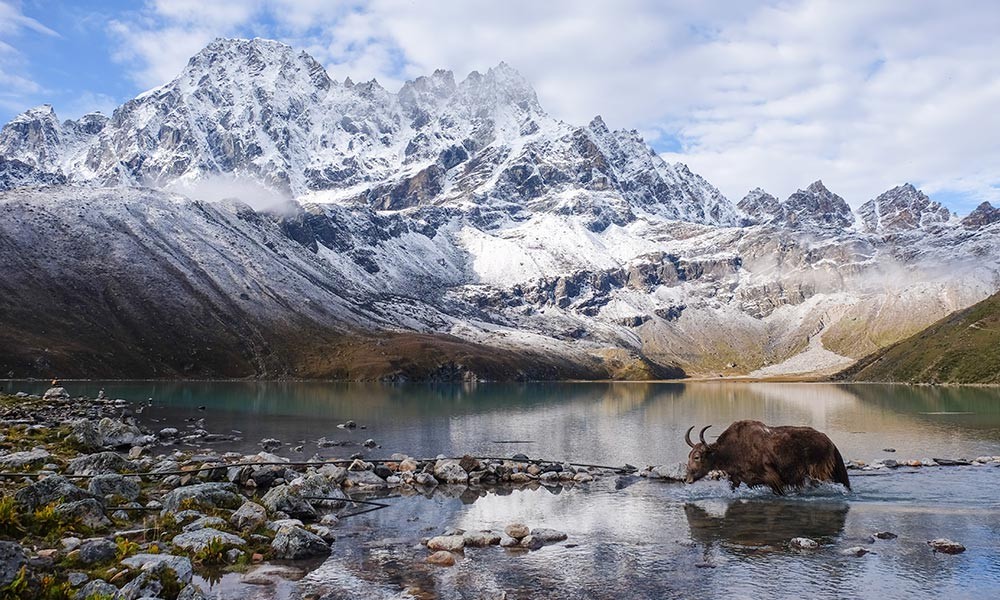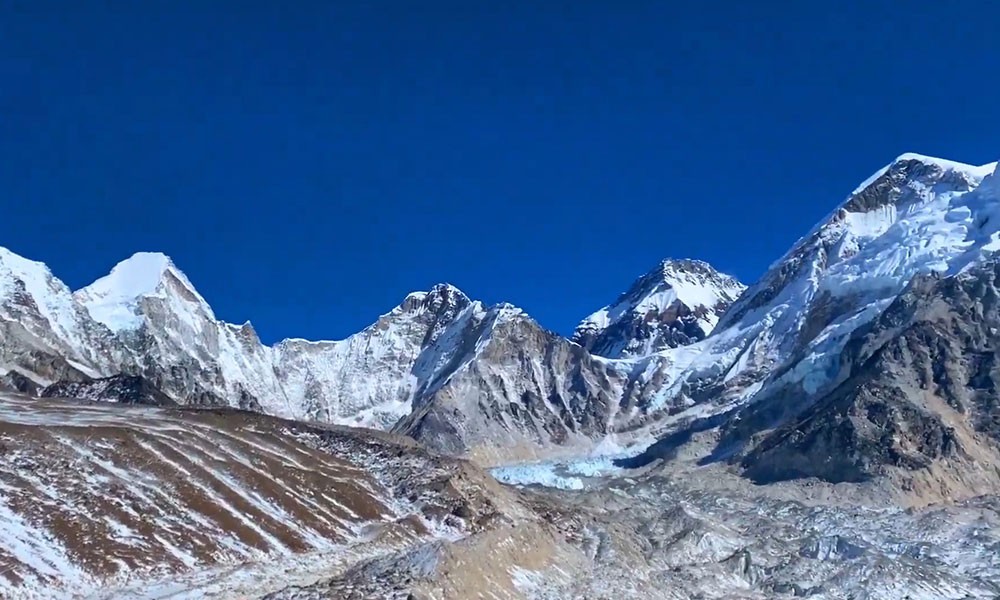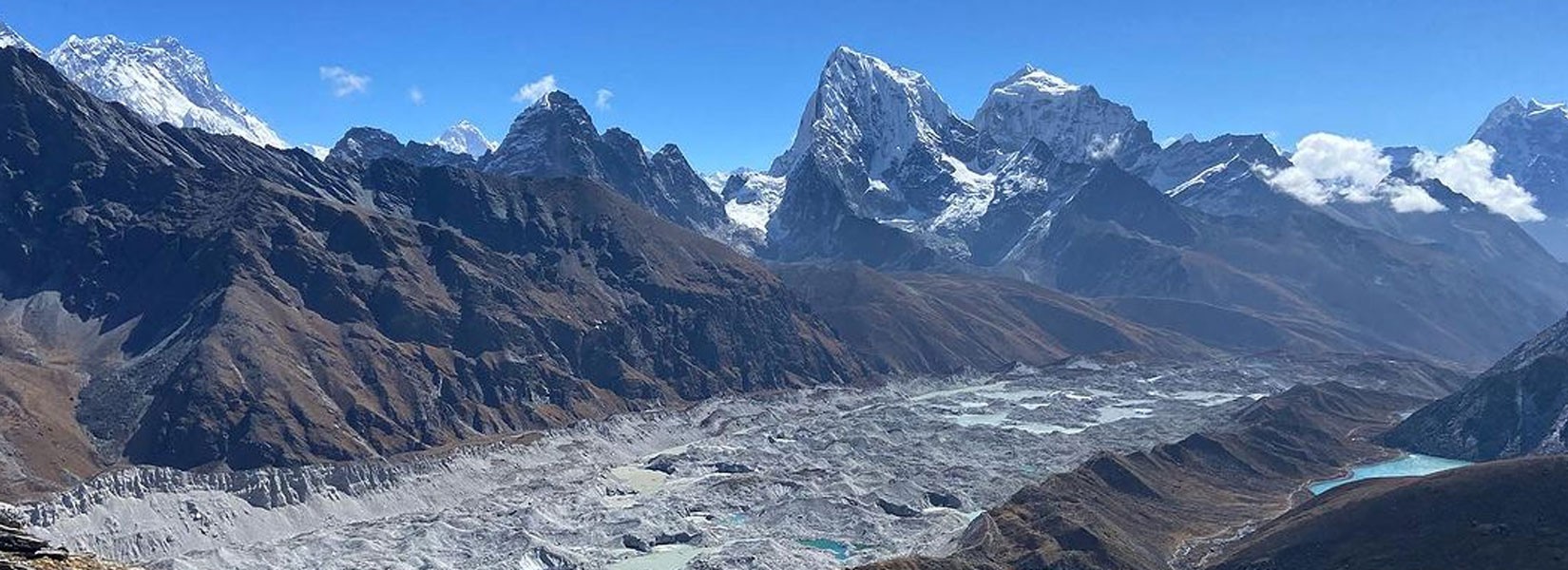Everest Base Camp Trek via Gokyo Lake Cost and Itinerary

Although the general margin of Everest Base Camp Trek via Gokyo Lake Cost is around US$ 1,450 to US$ 3,000, Marvel Adventure offers the standard 13 Day Everest Base Camp Trek via Gokyo Lake at just US$ 1,495.
This is the best value package in the market, and as we emphasize the experience of our guests, we don’t compromise on the integrity of the service. You can expect to enjoy a comfortable and immersive journey with us that you will treasure for your lifetime.
Everest Base Camp Trek via Gokyo Lake is a wonderful trekking adventure that introduces you to two of the major highlights in the Everest region with a single itinerary. Marvel Adventure’s standard 13 Day Everest Base Camp Trek via Gokyo Lake starts following the popular mainstream trekking route of the Everest Base Camp Trek.
After an incredibly exhilarating cross-valley flight, enjoy the epic views of the Himalayan massifs as you land in Lukla [2,800 meters/ 9,186 feet]. Then, gradually moving along the ascending route, you will trek from Phakding [2,610 meters/ 8,562 feet] to Namche Bazaar [3,440 meters/ 11,286 feet].
Acclimatization is very significant in high-altitude adventures in order to avoid the inconveniences caused by altitude sickness (symptoms start to appear at altitudes over 2,500 meters if you don't acclimatize properly. So, you will get a rest day at Namche before following the trails to the pristine glacial lake.
Making you ascend gradually across the Dole [4,200 meters/ 13,779 feet] and Macchermo [4,470 meters/ 14,665 feet], you will finally reach Gokyo Lake [4,790 meters/ 15,715 feet]. Then, after a morning hike to Gokyo Ri [5,357 meters/ 17,575 feet], the highest altitude jump point of Gokyo Valley, you will then make your descent to Dragnak [4,700 meters/ 15,419 feet].
The following day is one of the most exciting parts of this adventure as you will trek over one of the exciting high passes, Cho La Pass [5,420 meters/ 17,782 feet], to reach Dzongla [4,800 meters/ 15,748 feet]. From here, you will join the mainstream route and head toward Everest Base Camp [5,364 meters/ 17,598 feet] via Gorakshep [5,180 meters/ 16,994 feet].
But your trekking adventure only meets its conclusion after a morning hike to Kalapatthar [5,545 meters/ 18,192 feet] the next day. Then, you will trek down to Pheriche [4,200 meters/ 13,779 feet] and move along the descending route to Namche and Lukla for your flight back to Kathmandu [1,400 meters/ 4,593 feet].
Outline Itinerary

For a better understanding of the Everest Base Camp Trek via Gokyo Lake, you can check out the following itinerary plans. Remember, this is the itinerary plan of a standard 13 Day Everest Base Camp Trek via Gokyo Lake, the plans in other packages may differ depending on the duration, route, and the inclusion of other highlight explorations in the region.
Standard 13 Day Everest Base Camp Trek via Gokyo Lake
Day 01: Flight from Kathmandu (1,400 meters) to Lukla (2,800 meters) and trek to Phakding (2,610 meters)
Day 02: Trekking from Phakding to Namche Bazaar (3,440 meters)
Day 03: Acclimatization at Namche Bazaar
Day 04: Namche Bazaar to Dole (4,200 meters) trek
Day 05: Trekking from Dole to Macchermo (4,470 meters)
Day 06: Macchermo to Gokyo Lake (4,790 meters)
Day 07: Early morning hike to Gokyo Ri (5,357 meters) and trek down to Dragnak (4,700 meters)
Day 08: Dragnak to Dzongla (4,800 meters) trekking via Cho La Pass (5,420 meters)
Day 09: Dzongla to Gorakshep (5,180 meters) to Everest Base Camp (5,364 meters)
Day 10: Hike to Kalapatthar (5,545 meters) and trek down to Pheriche (4,200 meters)
Day 11: Pheriche to Namche Bazaar Trek
Day 12: Trek down to Lukla from Namche
Day 13: Flight back to Kathmandu from Lukla
What are the Inclusions and Exclusions in Our Package?

Here is the list of inclusions and exclusions of the standard Everest Base Camp Trek via Gokyo Lake Cost:
Everest Base Camp Trek via Gokyo Lake Cost Inclusion
- Airport pick and drop-off
- Cost of all domestic flights and airport tax mentioned in the itinerary plan
- All standard meals throughout the trek (breakfast, lunch and dinner)
- Government-licensed guide proficient in English
- Strong and helpful porter to carry your luggage (1 porter for 2 trekkers)
- Food, accommodation, salary, and insurance of guides and porters
- Teahouse/lodge accommodation facilities during the trek
- Sagarmatha National Park Entry Permit
- Pasang Lhamu Rural Munipcality Permit
- Comprehensive first aid kit including oximeter
- All government expenses and local taxes
Everest Base Camp Trek via Gokyo Lake Cost Exclusion
- Cost of your international flight and taxes
- Nepal Tourist Visa fee. Click here for more details.
- Travel insurance (mandatory for trek)
- Drinks, dessert, and snacks during the trek
- Tips to guides and porters (tips are expected)
- All personal nature expenses
Permits Required for Everest Base Camp Trek via Gokyo Lake

In this exploration of the two major highlights in the Everest region, you wil traverse through the conserved and restricted areas in the region. That's why, to do this trek, you will need to acquire three permits:
- Pasang Lhamu Rural Munipcality Permit
- Sagarmatha National Park Entry Permit
- Trekker’s Information Management System (TIMS)
In this remarkable Himalayan adventure, you will get the opportunity to explore the rich biodiversity of the Sagamatha National Park, and the permit to enter this park costs around US$ 30. Similarly, the Pasang Lhamu Municipality is graded as a special protected area inside the Everest region, and you will need a US$ 20 permit to enter the municipality.
Furthermore, you will also need the TIMS Card, which costs approximately US$ 17. This card has been implemented by the authorities for high-altitude adventures in Nepal. As the TIMS Card records the entry of the trekkers along different points in the trek, the search and rescue operations become more efficient during emergencies.
Difficulty and Considerations of Trek

As this Everest Base Camp Trek via Gokyo Lake is a combination of the two most popular trekking adventures in the Himalayas, you might be wondering about its overall difficulty level. Both Everest Base Camp Trek and Gokyo Valley Trek have been labeled as moderate Himalayan excursions.
There aren't any kind of technical or physically challenging sections along the trekking route of this mixed trek. You will also not need any prior trekking experience to do this trek. Still, this is a high-altitude Himalayan exploration in the region that is home to the highest peak in the world. So, you will have to consider several challenging factors of adventure and make preparations to overcome them.
Altitude Sickness
This exciting trekking adventure takes you across the high-elevation points of the Everest region. You will start your trek from Lukla (2,800 meters) after a flight from Kathmandu, and in the ascending route, you will traverse across high-altitude regions like Dole, Macchermo Gokyo Lake, Gokyo Ri, Dragnak, Dzongla, EBC, Gorakshep and Kalapatthar.
You will also cross one of the high Himalayan passes, Cho Las Pass (5,420 meters), in this trek. So, the risks of altitude sickness are high if you dont follow the proper precautionary methods and don’t acclimatize.
Trekking Distance
The total trekking distance of this mixed adventure is around 135 km, and you will cover the distance with 13 13-day itinerary in a standard package. So, the standard trekking distance is about 6 to 7 hours during each day of the trek. The trekking route that demands long hours of walking and gradually passes through the high-elevation points of the region is not easy to overcome if you are not physically prepared for it.
Climatic Conditions
If you have previously done any kind of high-altitude treks, then you understand how unpredictable the climatic conditions can be at high altitudes. The weather is especially erratic during the off-season. So, if you are new to high-altitude treks, make sure to pick the comfortable seasons for trekking, and don’t forget to pack the right layers. Be prepared for whatever weather conditions the Himalayas throw your way.
Khumbu Cough
Khumbu cough is another challenge during the adventures in the Khumbu region, which is caused due to low humidity and freezing climatic conditions. This dry cough is kind of persistent and can last for weeks if you don’t take proper care of yourself. Trekkers usually suffer from these coughing conditions if they don’t acclimatize properly at the rising altitudes and are exposed to the cold climatic conditions of the region. So, acclimatizing properly and keeping yourself warm is very important during high-altitude Himalayan adventures.
What is the Best Time for Everest Base Camp Trek via Gokyo Lake?

This fascinating and remarkable Himalayan adventure can be done throughout the year. The off seasons like monsoon (June to August) and winter (December to February) do bring some seasonal challenges along with them, but the trek can still be done. However, if you are looking forward to immersing yourself in the charming beauty of the region under pleasant weather conditions, we recommend spring (March to May) and autumn (September to November) seasons.
These peak seasons have favorable climatic conditions and offer a remarkable trekking experience surrounded by natural allurements. Autumn is known as the fall season and is the driest season of high-altitude adventures in Nepal. The lush-fresh landscapes after monsoon rain, colorful shades of grey, clear mountain vistas, mild temperatures, and colorful festivals make this season the number one season for trekking in Nepal.
Similarly, the spring season awakens the natural beauty of the region, and the colorful visual of nature’s peak season takes over the landscape. If you are a nature enthusiast, you certainly have to see the full glory of the Himalayan region in this season. The climate is also stable, and daytime temperatures are a little bit warmer, which makes your exploration, even at the alpine altitudes, a comfortable journey.
Temperature of Everest Region in Different Seasons
The temperature in the Spring Season: 17°C to 25°C (average)
Temperature in the Autumn Season: 12°C to 17°C(average)
Temperature in the Monsoon Season: 17°C to 30°C (average)
Temperature in the Winter Season: 5°C to 15°C (average)
** Note: This is just the general estimation of the temperature based on the precedent years' database and is purely based on the climatic conditions of the lower trekking region**
Who Can Do this Trek?

Everest Base Camp Trek via Gokyo Lake is certainly one of the most exciting and remarkable endeavors in the mainstream trekking region of the country. However, if you are concerned about the difficulty factors of this moderate trekking adventure, rest assured, they are still on milder terms.
None of the sections along the trekking route are technically demanding, and although the trail leads you to the high elevation points of the region, you will still get enough acclimatization before advancing further. Himalayan trekking packages in Nepal are designed for slow-paced walking, so you will acclimatize to new altitudes even at your trekking trails.
The Everest Base Camp Trek via Gokyo Lake has a success rate of 95%. If you have a basic fitness level and good health conditions, you are more than eligible for this Himalayan excursion. The further comfort level and enjoyability scale will depend on how much you prepare to overcome the moderately difficult trekking route of this high Himalayan adventure.
How to Train Efficiently for the Trek?

If you want to train more efficiently with the limited hours of your busy schedules for this trip, you need to do a proper physical assessment first. That will give you insights on the factors that you have to improve for the trek; you can also consult a guide or hire a trainer to design an effective plan.
You can adjust the length of your training period depending on your physical conditions, but the most general recommended period is 4 to 6 weeks for high-altitude treks. If you are physically active or exercise routinely, you can come up with your own training plan and decide its length after understanding the demand of the trails.
Praticse hikes to hill areas or mountains are also one of the constructive ways to prepare for this trek. You will understand the actual demand for the trails and also get the opportunity to test out your trekking boots and other gear.
Your overall training should be based on enhancing your strength and endurance level. Adding stamina training to your regime will further make the long duration of walking more enjoyable and comfortable.
Strength and Endurance Training Exercises: Lunge, Deadlift, Squat, Push Up, Pull Up, Dumbbell Row, Leg Raise, Toe Stand, Plank, Bicep Curl, Leg Extension, Crunch, Set Up, Glute Bridge, etc
Stamina Training Exercises: Stair Climbing, Cycling, Jogging, Swimming, Dancing, High Knees, Rowing, Mountain Climber, Burpee, Cardio, Jumping Rope, etc
Food and Beverages Available during the Trek

Everest region is the major mainstream and most popular trekking adventure in the Himalayas. So, naturally, the teahouses and services they provide are on a more advanced level than remote and isolated trekking regions. Similarly, you can enjoy an extensive set of eatery menus during this trekking adventure.
The food menus along the teahouse/lodges comprise a diverse range of cultural dishes as well as some international dishes with homely touches. You can expect the following meal options during your trek in the Everest region:
For Breakfast: Egg, Toast, Tibetan Bread, Muesli, Porridge, Pancake, Pudding, Fruit, Chapati, Selroti, Butter, Honey, Oats, Roti, Paratha, Naan, Chapati, etc
For Lunch and Dinner: Dal Bhat, Thakali Set, Dhindo, Momo, Chowmein, Curry, Thukpa, Sherpa Stew, Yak Steak, Shaphaley, Pizza, Sandwich, Spaghetti, etc
Beverages
Like the extensive range of food items, you will also be able to enjoy a diverse range of local and international beverages. Some of the most popular refreshing beverages along the teahouses are Masala Tea, Butter Tea, Ginger Lemon Honey Tea, Herbal Tea, Fresh Juice, Lassi, etc. You can also enjoy cold drinks and canned drinks at the teahouses when you are taking a breather in a long day’s trek.
In the alcoholic category, Chhyang, Raksi, Tongba, Aila, etc are the top choices among the locals. The teahouses also sell branded alcoholic drinks if you don’t develop a taste for the local drinks. However, alcohol consumption is not recommended during high-altitude treks in Nepal. Consuming alcohol can put your life at risk while navigating on challenging high-altitude trails, and it is also known to make acclimatization difficult.
As for water, you can refill your bottles at safe water stations along the trail, or your guide will fill your bottles for you. But make sure you use purification solutions to make the water safe for consumption.
What Kinds of Accommodation Are Available?

There are several modes of accommodation that you can choose from during this incredible Himalayan adventure. Guesthouses, lodges, camping tents, mountain huts, and luxury lodges are some of the most popular accommodation facilities in this trekking region. However, the teahouse trekking experience still remains one of the most popular accommodation modes among the trekkers during the Himalayan treks in Nepal.
The standard 13-Day Everest Base Camp Trek via Gokyo Lake is also a teahouse-based exploration activity in the Everest region. In your standard package, you can expect to stay about 12 nights at the lodges/teahouses on the mountain. If your package is lengthy and includes other itinerary plans, you will spend some additional nights at the teahouses en route.
Similarly, some trekking packages include accommodation at hotels in Kathmandu for 3 to 4 nights if they are handling your departure as well. Generally, the hotels in Kathmandu are of star-label, and the services and amenities provided by them are top-notch. However, in your standard trekking package to the Everest region, the accommodation facilities are pretty much of a moderate level.
You will rest in well-furnished and warm rooms; you will also receive basic amenities like mattresses, pillows, and blankets. But, for the extra amenities like hot showers, wifi, charging, laundry, etc, you will have to pay an extra charge.
Trip Safety
Marvel Adventures follows all safety protocols to ensure that your journey is a safe and enjoyable experience. Our guides are government-licensed and have significant years of experience in their particular area of operation. Most of our guides who are operating in the Everest region are natives of the Everest region or grew up in close villages. So, they know the trekking trails and safety protocols that need to be followed during the trek like the back of their hand.
Our guides also have received training for first aid and high altitude response; they can properly handle different kinds of issues related to general sickness, injury, and altitude sickness. Your guide will also check your health conditions during every day of your trek, including your body’s oxygen saturation level. In case of sickness or any kind of health-related hazard, your guide will take appropriate measures after consulting with the head office. Thus, you can just enjoy the magnificent trekking experience, leaving everything upto us.
For those looking to add an extra layer of challenge and adventure to their Himalayan journey, the Everest Three High Passes Trek is an excellent option. This trek not only includes the classic Everest Base Camp route but also takes you through three of the highest passes in the Everest region, offering breathtaking views and an unparalleled experience of the region's diverse landscapes.




















